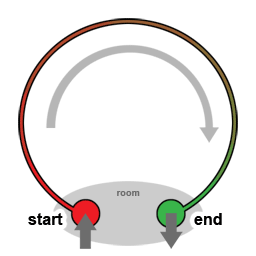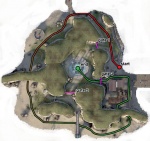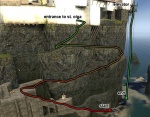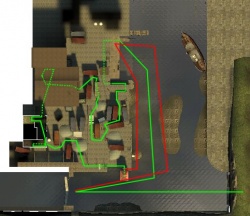Loops (level design)
Overview
A loop is a layout element that guides the player back to a previously seen or visited location. While it is still essentially a linear path created by the designer, it often doesn't feel that way. In fact, it is extremely useful in single player level design because of its linear properties. Why?
Illusion of Choice
Many games try to "empower" the player, who is often the main character and usually triggers most plot events. But single player levels are usually meticulously scripted and designed; divergence from the intended path can cause issues. Sometimes this intended path is very blatant and obvious, which results in a very artificial feel to the level. The designer intentions become clear and the game becomes a routine of jumping through placed hoops rather than genuine interaction. Loops can partially mask the intended path and make a level feel more nonlinear and spontaneous.
Immersion
In real life, we travel in loops all the time. Everyday, you may take a certain route to school or work, and visit these locations repeatedly. There are probably several reasons why you travel along this route, such as efficiency or speed of use. Loops can make players feel more like they're in a real place, rather than a collage of vertices and textures made by a single human.
Resources
Levels can only be so large; time and BSP file format limits are large factors of the level design process. Making the player's path loop back to itself will save space, memory, and time. Would you rather design three small rooms that the player will visit for 5 minutes each, or one large room that the player will visit for 15 minutes? Loops can save resources and time for the author.
Guidance
Overly Non-linear design can often be a bad thing. If players are given too much choice they might not know what to do with it, or find the layout confusing. However, overly linear design can also be a bad thing, as it can make progression feel fake, predictable and boring. A balance is generally the best approach; levels with choices that also give guidance in the form of in-game hints, other characters, signs, or other cues.
Loops fit into this very well, they can make the player reflect on their past experience and re-evaluate their goals: "I remember I entered the level on that balcony over there, after fighting the helicopter." This will guide the player back to the intended path and indirectly remind them of their objectives while also allowing for a degree of non-linearity along the way.
At certain times though, loops are wildly inappropriate. Use them with caution, as they can backfire. For example, the Water Hazard and Highway 17 chapters of Half-Life 2 would lose all significance if large portions were composed of loops. The goal of these chapters is to elicit a sense of progress and movement away from City 17 - a journey of sorts. Having the player drive for miles, only to end up on the other side of a locked door encountered earlier, will more likely frustrate than immerse the player.
Examples
Implementing loops requires some inventive thinking. Try to think of your level layout as one large location that the player explores, rather than an arbitrary collection of corridors and rooms. Here are some particularly notable examples:
Questionable Ethics (Half-Life)
This chapter begins with a retinal scanner locking a door that's vital to open. The player already knows that only friendly NPCs can operate scanners, so they begin looking for friendly NPCs. The rest of the level loops back into this room, so no matter what, the player will always come back to the retinal scanner and remember to look for scientists.
The level layout forms a rough loop, with many doors initially locked (especially the door marked in pink on the diagram). Gradually, the level opens up, ending with the player meeting the scientists and leading them to the retinal scanner. Helped by a consistent visual style, the nonlinear layout makes the chapter much more immersive and unique.
Metastasis 1 (MINERVA: Metastasis)
This map consists of an island and the bunker complex underneath. The player's goal is the giant beam array in the middle of the island, but every gate is locked. Thus, the player explores the rest of the island to find a path to the middle, and travels one large loop around the island in the process. When the gates in the middle are unlocked, the rest of the island is freely accessible and becomes an open battlefield. An excellent example of a loop.
The beam is a global landmark, visible from virtually anywhere on the island. The beam is also an object that the player would naturally gravitate towards - after all, how often does a giant blue stream of energy tunnel down into an island? An on-screen text message tells the player what way to travel, but even without this, there's a constant stream of Combine soldiers in the opposite direction that nudge the player to retreat that way, which is the most realistic move to make. Consider the scenario if there weren't Combine soldiers; the player would move towards the pier, discover the door was locked, shrug, and travel north. The soldiers act as a subtle direction device to nudge the player north to begin the loop around the island.
Half-Life 2: Lost Coast
This small tech demo made by Valve has two main parts: a cliffside and a church on the top. The players starts at the bottom, and meets a fisherman who tells them to go to the top. Forcing the player to travel upwards focuses the player's attention upwards, in turn drawing attention to Combine soldiers repelling downwards. Finally, the player reaches the top and accomplishes their objective by breaking a headcrab canister launcher.
This particular loop is only clear at the very end of the map, and thus serves a different purpose from others. After a climatic fight with a helicopter, the player takes a lift down to the bottom. While most loops are concerned with efficient utilization of map possibilities and gameplay, this loop instead serves as an emotional book-end of sorts. Also, note that the mapper(s) could have simply forced players to travel back down by backtracking and retracing their steps down the cliffs, thus inflating the gameplay time. Having the player easily return back to the fisherman achieves a sense of closure and achievement.
Water Hazard (Half-Life 2)
The player has to fight through a rather long and more complicated structure with enemies in the way. After the player has opened the gates, the time that would be spent extensively backtracking would be very long and boring. That time can be saved though by use of a small pier that can only be accessed by the same path to the player's objective (do note: this pier can be reached unintendedly if the player uses the airboat as a ramp, which renders this nice loop into a small bounce). This pier is made obvious to the player before beginning the loop by placing a metrocop on it. This allows diversity in the player's journey without the risk of boring the player.
It is important to remember that harder loops like these should not be too hard, or it might spoil the game experience totally or lure the player into noclipping through locked doors. In this case, there are both a number of metrocops and a hunter chopper against the player but rarely both at once.




